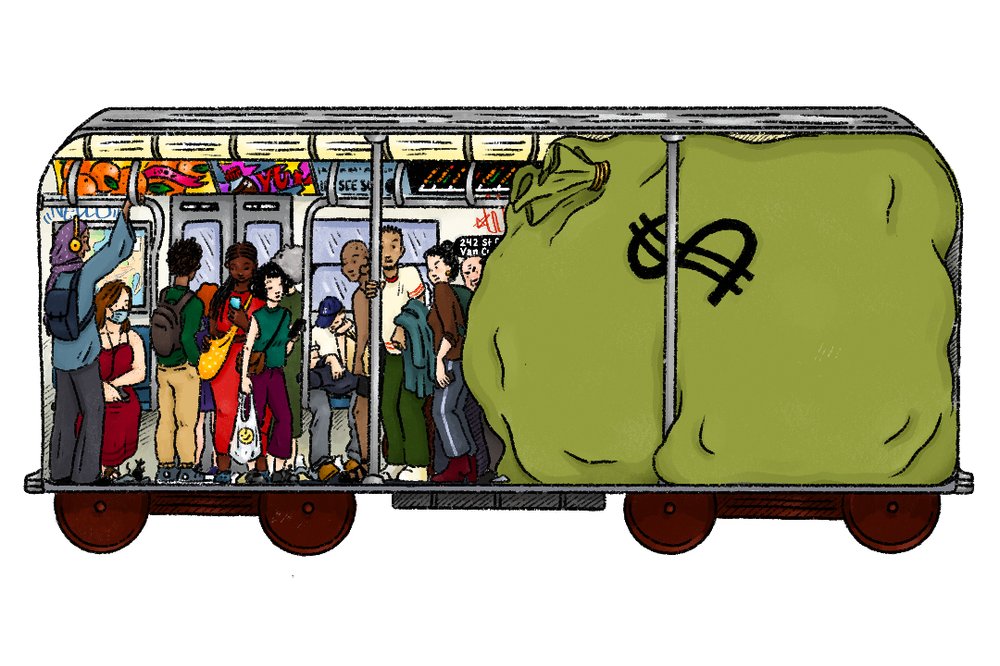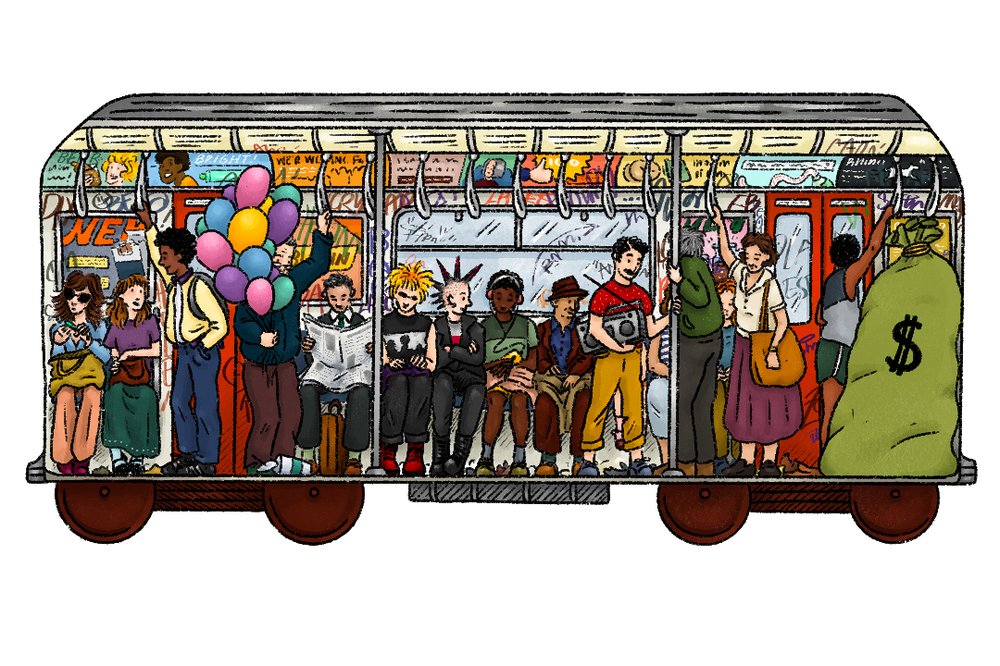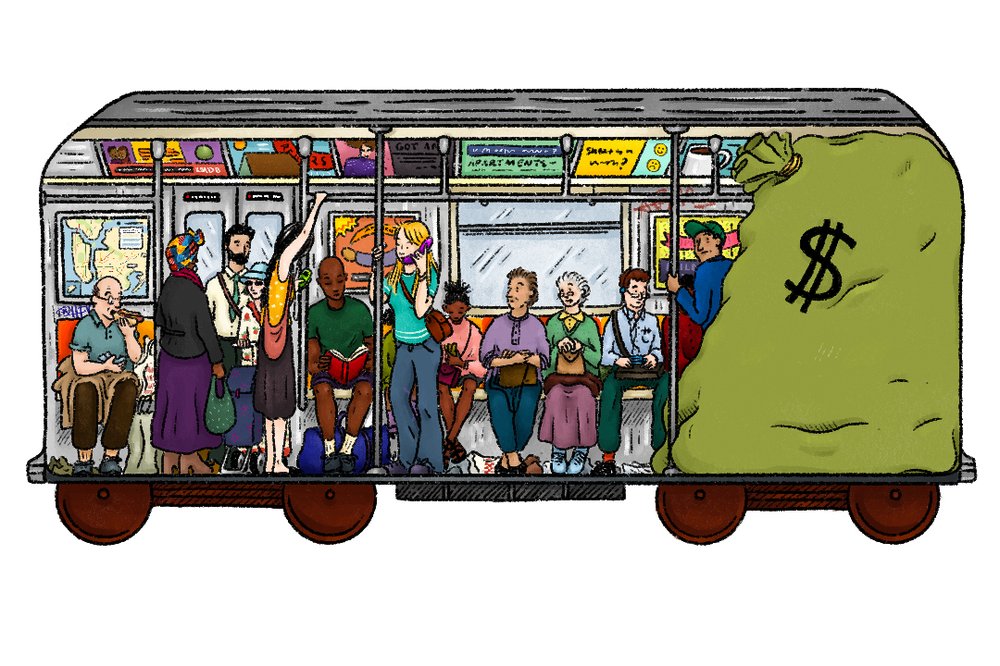A $48 billion debt is crushing the MTA. Paying it off could disrupt the future of NYC transit.
June 21, 2023, 5:01 a.m.
The MTA first took out $2.5 billion in debt in 1981 to fix the crumbling subway system. Since then, the agency has come to rely more and more on debt. The MTA now owes $48 billion, and will pay more than $3 billion to lenders this year.

In 2023, the MTA, straphangers and New York taxpayers are on the hook for more than $3 billion in debt payments. That represents more than 40% of the agency's fare and toll revenues for the year.
New York’s Metropolitan Transportation Authority is buried under a $48 billion mountain of debt — and paying it off threatens to undermine the agency’s core function: running mass transit for more than 5 million people a day.
For the last 40 years, the MTA has taken out loans to help pay for new tracks, stations, trains and buses — and maintain the ones it already owns. Money from fares, tolls and taxes pays back the lenders, plus interest.
That business model worked until the pandemic sent ridership plummeting. This year, the payments on the debt are slated to exceed $3 billion – a 600% increase from $425 million in 1993, according to a Gothamist investigation.
Now, the MTA faces a harsh reality: Its decades-old methods for managing money it owes have been broken by the COVID-19 pandemic.
Ridership is down roughly 30% from pre-pandemic levels, meaning the city’s mass transit systems are clocking about 2.7 million fewer rides per day than in 2019. Meanwhile, the agency’s debt payments have over the last 30 years increased at three times the rate of inflation. The agency faces limited options in the coming years to pay back bondholders – largely banks – who under the terms of the deals must get their money, even if that means worse service for riders.
The MTA averted a financial crisis in May when state lawmakers approved a tax hike and the use of revenue from new casinos to help balance its books. The so-called fiscal cliff had top transit officials sounding the alarm centered on a $600 million operating deficit for the coming year – a mere fraction of the agency’s overall debt.
The agency plans a fare hike later this year. But the MTA’s financial documents show officials are “uncertain” whether the agency will have enough money to stay afloat beyond 2026.
State Comptroller Thomas DiNapoli told Gothamist the agency’s “budgets are precariously balanced” and warned that more subsidies may be needed to prevent service cuts in the coming years.
The MTA’s grim financial health is made worse by the ever-growing pile of debt.
“I think you could see a funding crisis around the corner,” DiNapoli added, noting the debt burden “certainly plays a role, because it is a growing part of the budget.”
Gothamist reviewed more than 40 years of MTA financial documents and reports and interviewed more than a dozen experts on the loan agreements. In total, 63% of the MTA’s latest construction plan will be paid for with debt. The bulk of that debt will be financed by new taxes and surcharges — but it means New York’s straphangers, drivers and taxpayers will be left paying for billions in interest and fees owed to bondholders over the coming decades.
The documents and interviews revealed the MTA’s current financial crisis could have been avoided — or been far less dire — had New York elected officials not put so much of the agency’s expenditures on a credit card.
“We have papered over our failure to deal with a lot of difficult, long-term issues with more borrowing,” said Nicole Gelinas, a fellow at the Manhattan Institute. "To make a long story short, we've gone from zero debt in the early 1980s to close to $48 [billion], $50 billion in long-term debt by 2023."
Growing debt payments
This year, the amount the MTA will pay on its debt represents about 40% of the agency’s expected fare and toll revenues. Two decades ago, that ratio was about 20%. And two decades before that, in 1984, it was less than 4%.

In the early 1980s, the MTA began taking on debt to help pay for for mass transit improvements. In 1983, less than 4 cents from every dollar the MTA collected from transit riders went to pay off its debts.
An MTA statement to lenders in April, which was issued while a budget deal to plug its operating deficit appeared uncertain, highlights how the agency views its obligations to the banks in a crisis.
“Simply returning to a pre-pandemic service structure and service levels, without appropriately matching service with ‘new normal’ demand, would continue the unsustainable structural fiscal imbalances that must be addressed and corrected,” the MTA wrote in the disclosure governed by federal securities law.
In other words, when faced with a financial crisis, the MTA told its lenders that service cuts could be necessary to make debt payments as required.
The money the MTA will pay the banks this year is enough to run the entire mass transit systems in Chicago or Washington, D.C. The agency’s $48 billion pile of debt is nearly the same amount as Gov. Phil Murphy’s spending plan to run the entire state of New Jersey for a year.
This year’s debt payments would be enough to give transit advocates key items they’ve long desired, such as a boost in service that would send trains through every station every six minutes throughout the day, which the group Riders Alliance estimates would cost $300 million a year. The debt payments could also pay for free bus service for everyone – several times over.

By 2003, the payments on the MTA's debt had grown so large they represented about 20% of all the money the agency collected in fares and tolls.
As subways crumbled in the 1970s, the MTA turned to debt
The original purpose of the MTA’s debt was a noble one: to save mass transit in New York during the financial crisis of the 1970s. By 1980, the agency reported 71,773 train breakdowns on the subways, more than double the number of breakdowns compared to only three years prior, according to figures reported by the Daily News at the time. Signals directing trains on 20 miles of subway tracks dated back to 1917, early MTA debt documents show.
“The fiscal crisis in New York City obviously had caused some of the problems, but there had been decades of poor maintenance, of lack of investment in the subway system,” said Joe Rappaport, who worked for the Straphangers Campaign advocacy group in the 1980s and 1990s. “So finally, someone woke up and put together a plan.”
Enter Richard Ravitch, who was appointed MTA chairman in 1979. Ravitch, who was desperate for money to buy new train cars, replace aging train tracks and maintain existing infrastructure, turned to the banks.
In 1981, he pushed through legislation that allowed the MTA to take on $2.5 billion in debt to pay for mass transit repairs. That debt was to be paid off by fares, bridge and tunnel tolls, and new taxes.
“That was in many ways my greatest achievement in my life was to get those laws passed, because that's what provided the MTA with the capital to rebuild,” Ravitch, now 89, recalled. “Everything that was built in this city was built with debt. How else do you get the money?”
Ravitch’s plan worked. In the early 1980s, the MTA bought more than 1,300 new subway cars. It also upgraded stations and overhauled tracks and signals across the region’s mass transit network. And in 1988, service had improved and the total subway rides for the year exceeded 1 billion, up from 938 million in 1982, when the MTA first took on debt.

But the loans came at a heavy cost. The annual interest on the debt was as high as 10.4%. A Gothamist review found that $250 million of the initial debt taken on by the MTA in 1982 came with $555.8 million in interest over 25 years. That’s more than double the cost of the loans themselves.
Increasing reliance on debt
A decade after Ravitch enacted his borrowing plan, Gov. George Pataki decided to reduce subsidies for mass transit, arguing that the state’s government had grown too large and was spending too much money. The MTA turned to even more debt to pay for improvements and maintenance.
The numbers from this period mark a dramatic escalation in the use of debt – one that continues to this day.
MTA data shows the agency’s five-year capital plans to maintain and upgrade mass transit between 1995 and 2005 on average relied on debt for nearly 43% of financing.
The MTA, its riders and New York taxpayers are still paying off those loans today.
“We still are carrying debt that was issued upwards of 30-plus years ago now,” said Kevin Willens, the MTA’s chief financial officer. He emphasized the MTA’s debt management is not as bad as that of the federal government, which “just issues, issues, issues and never pays down. We actually are paying down debt every year.”
Robert Paaswell, a CUNY professor and former CEO of the Chicago Transit Authority, laid it out more plainly. He said Pataki’s decisions are hurting mass transit service in New York. The agency borrowed at such high interest rates that the cost affects quality of service, he said.
“What you want to do is borrow a little at low interest, and see if you can pay it back or have it paid back from other sources,” he added. “But to let it get so high means that you're going to have gaps in operating. And that's a terrible thing, especially now when you're trying to get people to come back to transit.”
Gothamist reached out to Pataki multiple times through his assistant for comment on this story, but the ex-governor did not respond.
A good deal for banks
Banks and bondholders have always been happy to lend the MTA money, and the MTA keeps coming back for more.
By 2002, the MTA’s debt payments grew so large the agency and state lawmakers took steps to refinance the loans, like a homeowner might refinance their mortgage. State officials commissioned the firm Bear Stearns to come up with a plan to overhaul its debt portfolio. The firm’s head of public finance, Robert Foran, orchestrated the plan.

A 2003 state comptroller report estimated the move saved the MTA $650 million in the short term, but warned it would rapidly escalate the amount the agency paid to service its debt each year. Records show the MTA paid $793 million for debt service in 2002, the year the restructuring was implemented. By 2008, the figure doubled to $1.6 billion.
In 2010 — less than two years after Bear Stearns’ collapse — Foran was hired as the MTA’s CFO, where he managed the debt he helped restructure until he retired from the agency in 2021. Foran did not respond to requests for an interview.
Rising costs compound debt
As the MTA has come to rely more on debt to fund service improvements, the costs of those improvements have skyrocketed.
Although there have been few expansions to New York City’s mass transit system over the last 40 years, they’ve cost far more than anywhere else in the world. The most egregious example is the MTA’s East Side Access project, which opened this year with Long Island Rail Road service into the new Grand Central Madison station beneath Grand Central Terminal.
In 2006, the Federal Transit Administration agreed to give the MTA $2.6 billion to build the project. That year, the MTA estimated the project would cost $6.3 billion.
But chronic construction delays and mismanagement made the final price tag $12.7 billion – a figure that federal records show includes debt service payments and future plans to order new LIRR cars.
A report published last year by researchers at NYU found the Grand Central Madison project was the least cost-efficient mass transit expansion project in the history of the world.
The federal government didn’t pay a nickel for the project’s increased costs. The MTA primarily used debt to pay for the extra $6 billion, which New York taxpayers and straphangers are now paying off.
“Why are we borrowing so much money? Because the MTA makes poor decisions with what it's going to spend that money on,” said Gelinas. “We're not getting as much as we should for our money.”
MTA officials pointed to other recent projects that came in on budget — like the installation of a new track for the LIRR that opened last year — as evidence the agency is becoming more efficient.
The MTA’s current $52 billion capital plan — which officials promised would save the subway after it had once again fallen into disrepair — relies even more heavily on debt.
It includes roughly $8 billion in new debt that must be paid off by fares, tolls and MTA-dedicated taxes that were established starting in the 1980s. But another $25 billion of the capital plan is to be financed through debt paid off by new revenue streams.
Those new revenue streams, approved in 2019 by former Gov. Andrew Cuomo and the Legislature, include the MTA’s incoming congestion pricing program that will toll motorists who drive in Manhattan south of 60th Street, a sales tax on internet purchases and a “mansion tax” on real estate sales of more than $1 million.
As the MTA’s debt payments continue to grow — and as riders remain slow to return to mass transit — experts warn the agency could face a “death spiral” in the coming years without more government subsidies. Under that scenario, the MTA would be forced to cut service, pushing riders away from mass transit and leaving the agency with less money to run trains and buses.
“If you can't implement your capital plan and your system falls into disrepair, it’s going to make it harder for people to want to use the trains and the subways and the buses,” DiNapoli said.